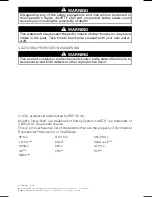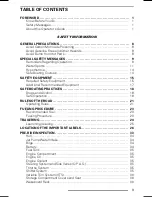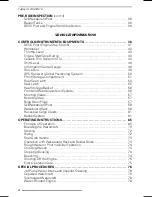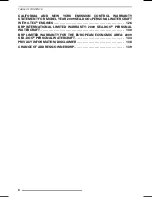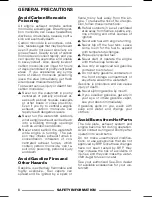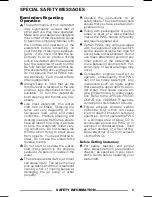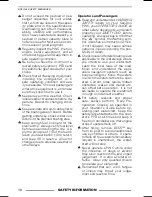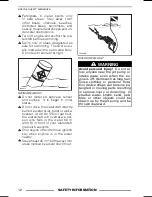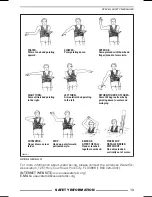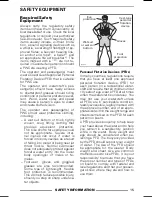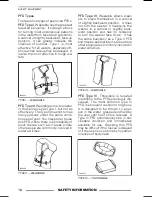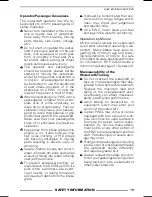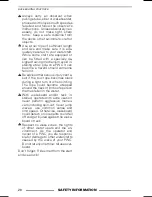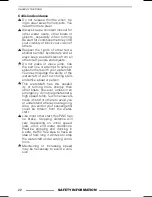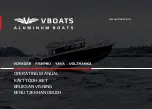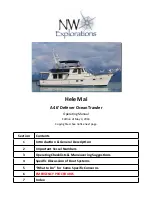
GENERAL PRECAUTIONS
Avoid Carbon Monoxide
Poisoning
All engine exhaust contains carbon
monoxide, a deadly gas. Breathing car-
bon monoxide can cause headaches,
dizziness, drowsiness, nausea, confu-
sion and eventually death.
Carbon monoxide is a colorless, odor-
less, tasteless gas that may be present
even if you do not see or smell any en-
gine exhaust. Deadly levels of carbon
monoxide can collect rapidly, and you
can quickly be overcome and unable
to save yourself. Also, deadly levels of
carbon monoxide can linger for hours
or days in enclosed or poorly ventilated
areas. If you experience any symp-
toms of carbon monoxide poisoning,
leave the area immediately, get fresh
air and seek medical treatment.
To prevent serious injury or death from
carbon monoxide:
Never run the watercraft in poorly
ventilated or partially enclosed ar-
eas such as boat houses, seawalls
or other boats in close proximity.
Even if you try to ventilate engine
exhaust,
carbon
monoxide
can
rapidly reach dangerous levels.
Never run the watercraft outdoors
where engine exhaust can be drawn
into a building through openings
such as windows and doors.
Never stand behind the watercraft
while engine is running. The per-
son may inhales exhaust fumes in
concentration. Inhalation of con-
centrated exhaust fumes, which
contain carbon monoxide, can re-
sult in CO poisoning, personal injury
and death.
Avoid Gasoline Fires and
Other Hazards
Gasoline is extremely flammable and
highly explosive.
Fuel vapors can
spread and be ignited by a spark or
flame many feet away from the en-
gine. To reduce the risk of fire or explo-
sion, follow these instructions:
Refuel outdoors in a well ventilated
area away from flames, sparks, any-
one smoking and other sources of
ignition.
Never add fuel with engine running.
Never top off the fuel tank. Leave
some room for the fuel to expand
with temperature changes.
Wipe up any spilled fuel.
Never start or operate the engine
with the fuel cap removed.
Use only an approved red gasoline
container to store fuel.
Do not carry gasoline containers in
the front storage compartment or
anywhere else on the watercraft.
Gasoline is poisonous and can cause
injury or death.
Never siphon gasoline by mouth.
If you swallow gasoline, get any in
your eye or inhale gasoline vapor,
see your doctor immediately.
If gasoline spills on you, wash with
soap and water and change your
clothes.
Avoid Burns from Hot Parts
The ride plate, exhaust system and
engine become hot during operation.
Avoid contact during and shortly after
operation to avoid burns.
Do not make unauthorized modifica-
tions, or use accessories that are not
approved by BRP. Since these changes
have not been tested by BRP, they
may increase the risk of accidents or
injuries, and they can make the water-
craft illegal for use on water.
See your authorized Sea-Doo dealer
for available accessories for your wa-
tercraft.
8
________
SAFETY INFORMATION
________
Summary of Contents for 2009 Sea-Doo GTI Series
Page 9: ...SAFETY INFORMATION ________ SAFETY INFORMATION ________ 7...
Page 39: ...VEHICLE INFORMATION _______________ 37...
Page 83: ...MAINTENANCE INFORMATION _______________ 81...
Page 100: ...STORAGE AND PRESEASON PREPARATION 98 ______________...
Page 101: ...TECHNICAL INFORMATION _______________ 99...
Page 114: ...SPECIFICATIONS 112 ______________...
Page 115: ...TROUBLESHOOTING ______________ 113...
Page 123: ...WARRANTY ______________ 121...
Page 142: ...140 ______________...
Page 144: ...142 ______________...
Page 146: ...144 ______________...


